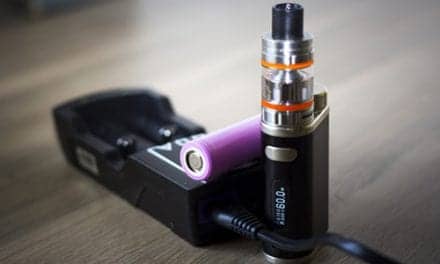Clinicians agree that counseling patients on the potential effects of vaping and screening early with pulmonary function testing can reduce harm, but there is still a lot to learn about the health consequences of e-cigarettes.
By Lisa Spear
E-cigarettes are a relatively new way to consume nicotine, so there are still many unanswered questions about how the lungs of someone with decades of e-cigarette exposure will look down the road, but it is already clear that the chemicals inhaled from vape pens irritate tissues deep in the lungs.
“Our lungs have evolved over millions of years to accommodate the air that is in our environment. Anything beyond that, whether it is dust, whether it is pollutants, it is going to irritate the lungs in some capacity and vaping is just that— those are noxious stimuli — they are not designed for the lungs. Your lungs will fight that,” said Panagis Galiatsatos, MD, MHS, an assistant professor in the Division of Pulmonary and Critical Care Medicine at Johns Hopkins University. “Those noxious chemicals, toxins, will have immediate consequences and potential long-term consequences,” he said.
Also, since there is so much variety and little oversight in the e-cigarette market, it is often challenging for clinicians and scientists to nail down the exact ingredients in these products, measure the amount of nicotine and other substances that are inhaled, and pinpoint the chemical reactions that may occur before the vape fumes hit the lungs.
“This is trickier than with combustible cigarettes — With combustible cigarettes, if someone tells us how many cigarettes they smoke in a day or how many packs they smoke in a day — we have a way of quantifying that because with regular cigarettes, while there are different brands, the quantities are generally pretty similar,” said Krishna P. Reddy, MD, MS, investigator at the Medical Practice Evaluation Center and the Tobacco Research and Treatment Center at Mongan Institute and the division of pulmonary and critical care medicine at Massachusetts General Hospital and Harvard Medical School.
“But with e-cigarettes there are so many products on the market, so actually quantifying how much someone actually vapes is hard because it depends on what they are vaping. Are they using JUUL? Are they using Puff Bars? Are they using stuff that their friend made in their basement?” Reddy said.
What’s in the Vapor?
Emerging research shows that many of the lung irritants found in e-cigarettes are far from harmless, and some e-cigarettes in circulation come with unexpected additives. In April of this year, school officials in West Virginia disclosed that urine and heroin were found in vape cartridges circulating within the school system. Earlier reports highlighted how some vape liquids had contained vitamin E, which was blamed for severe cases of lung injury. In 2019, the US Centers for Disease Control and Prevention issued new guidance on evaluating and caring for patients with suspected vaping lung injury after 1,299 cases in multiple states were linked with the use of electronic cigarettes.1
Although rare, in the most extreme cases, patients might become hospitalized with e-cigarette or vaping use-associated lung injury (EVALI) vaping-associated airway distress syndrome (VARDS).2
“One thing is clear: Vaping is not safe,” said Reddy. “It is probably not as harmful as combustible tobacco products, but we certainly do see patients come in with problems caused by vaping.”
Vaping + Smoking
When mixed with combustible cigarettes, vaping can become even more troublesome. Often touted as a strategy to wean cigarette smokers off tobacco, research suggests the process of making that transition from cigarettes to vapes, when a person might vape and smoke during the same period of time, can lead to worse respiratory symptoms.
One recent study linked the dual use of both combustible tobacco and e-cigarettes to an increase in respiratory symptoms such as coughing and wheezing.3 This research suggests that while vaping and smoking are both harmful, patients may unknowingly cause even more harm by swapping out only some of their cigarettes for a vape pen when they are trying to quit smoking.
“This study helps identify how e-cigarettes can best be used to reduce the harms caused by smoking cigarettes. Exclusive e-cigarette use did not increase the risk of new respiratory symptoms while using both products (e-cigarettes and cigarettes) did,” says senior author Nancy Rigotti, MD, director of the Tobacco Research and Treatment Center at Massachusetts General Hospital and a professor at Harvard Medical School.
At the start of the study, published in the American Journal of Respiratory and Critical Care Medicine, the patients surveyed had no respiratory symptoms. After about one year, researchers documented respiratory symptoms in 10.7% of those who did not use e-cigarettes or tobacco cigarettes, 11.8% of those who only use e-cigarettes, 17.1% of exclusive tobacco smokers, and 19.7% of those who both vaped e-cigarettes and smoked tobacco cigarettes.
Dual users had a 1.9-times higher chance of developing respiratory symptoms compared with exclusive e-cigarette users and a 1.24-times higher chance compared with exclusive tobacco smokers.
Using PFT to Assess Effects of Vaping
Reddy explains that he sees young people in his clinic wheezing and coughing due to e-cigarette use. In some cases, people who vape will experience a decrease in lung function, detectable on pulmonary function testing.
His expectation is that much of the damage can be reversed, especially in those patients who have not been vaping for a very long time, he says, but more research is needed to understand the implications of long-term use.
Unsurprisingly, people with asthma and other underlying respiratory conditions could fair worse when exposed to vape fumes. For instance, in one recent study of asthmatic patients, vaping resulted in acute alteration of both pulmonary function and airway inflammation.6
To prevent the most severe outcomes, screening early is the first step. “All patients should be asked whether they vape. It is something that is unrecognized in the medical community overall. A lot of clinicians are used to asking about smoking, but not as used to asking about vaping,” says Reddy.
If a patient vapes and is exhibiting respiratory symptoms, has experienced recent bouts of pneumonia or bronchitis, pulmonary function testing is a next step to evaluate how well the lungs are functioning.
Using a spirometer, the pulmonary function test will measure forced expiratory volume (FEV1), how much air someone can blow out in one second if they blow out as hard as they can. Pulmonary function testing also measures how much air the patient can blow out in total, the forced vital capacity (FVC).
Pulmonary function testing is regularly used to diagnose chronic obstructive pulmonary disease (COPD), asthma, and can help evaluate patients who vape. “If they have abnormalities in those numbers, that can be a red flag,” said Reddy. “Even if those numbers are in the normal range, it could be helpful to check over time, every few months or once a year, to see if there are changes over time.”
The best approach, clinicians agree, is always to advise the patient to stop vaping. Nobody knows for sure if and what kind of permanent lung damage from vaping we will see in the decades ahead. No one knows yet, for instance, if vaping causes lung cancer or what, if any, impact vaping could have on the heart. For now, we can only make educated guesses about what a lifetime of vaping will do to the human body.
“What we do know is that vaping is not harmless,” said Reddy. “But when you put all the studies together, so far, it looks like vaping is not as bad as smoking combustible cigarettes in terms of its effect on lung function, in terms of the types of symptoms that it causes, in terms of its short-term health outcomes.”
RT
Lisa Spear is associate editor of RT magazine. For more information, contact [email protected].
References
- Siegel DA, et al. Update: Interim Guidance for Health Care Providers Evaluating and Caring for Patients with Suspected E-cigarette, or Vaping, Product Use Associated Lung Injury — United States, October 2019. MMWR Morb Mortal Wkly Rep 2019;68:919–927. DOI: http://dx.doi.org/10.15585/mmwr.mm6841e3external icon
- Lilly CM, et al. Vaping-Associated Respiratory Distress Syndrome: Case Classification and Clinical Guidance. Crit Care Explor. 2020 Feb 24;2(2).
- Reddy KP, Schwamm E, Kalkhoran S, Noubary F, Walensky RP, Rigotti NA. Respiratory Symptom Incidence among People Using Electronic Cigarettes, Combustible Tobacco, or Both. Am J Respir Crit Care Med. 2021 Jul 15;204(2):231-234.
- Kotoulas SC, Pataka A, Domvri K, Spyratos D, Katsaounou P, Porpodis K, Fouka E, Markopoulou A, Passa-Fekete K, Grigoriou I, Kontakiotis T, Argyropoulou P, Papakosta D. Acute Effects of E-cigarette Vaping on Pulmonary Function and Airway Inflammation in Healthy Individuals and in Patients with Asthma. Respirology. 2020 Oct;25(10):1037-1045.










